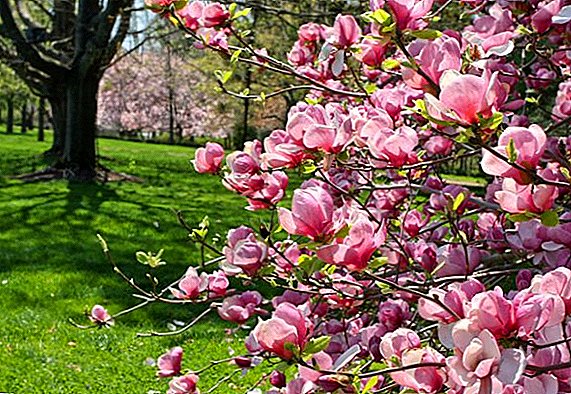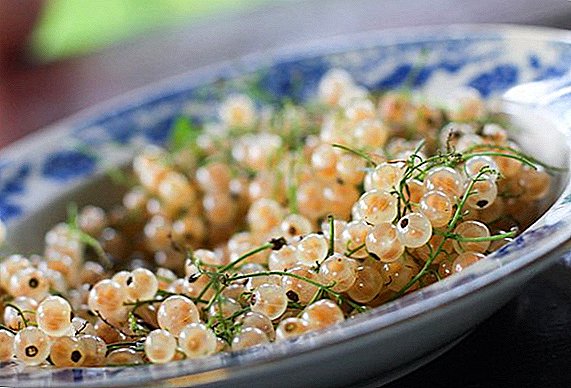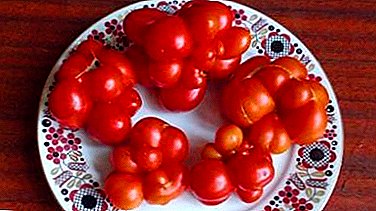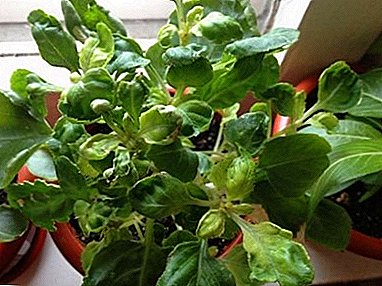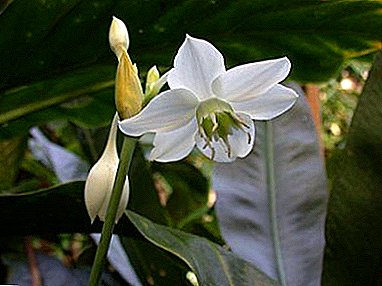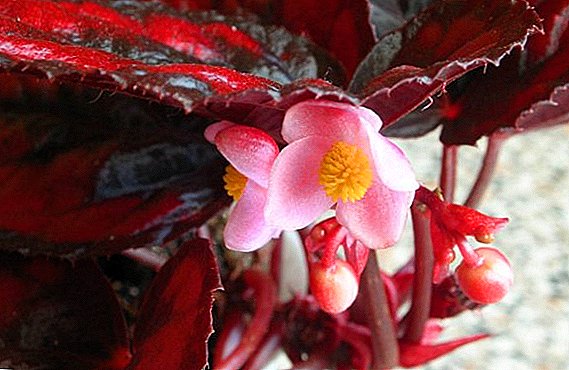 They say that in the first post-war difficult years, the only decoration of communal apartments and modest rural huts was the red-leaved begonia. As unpretentious as her masters, she blossomed brightly, even defiantly against the backdrop of a poor housing. And pleased the inhabitants of the home, remaining in the memory of a happy childhood. This flower is still the best option for those who make their debut as a florist.
They say that in the first post-war difficult years, the only decoration of communal apartments and modest rural huts was the red-leaved begonia. As unpretentious as her masters, she blossomed brightly, even defiantly against the backdrop of a poor housing. And pleased the inhabitants of the home, remaining in the memory of a happy childhood. This flower is still the best option for those who make their debut as a florist.
Description of indoor plant begonia krasnolistnaya
Another name for the red-leaved begonia is Fista. She came to Europe from South America. We call it that because the leaves have two colors at the same time: their lower side is red or burgundy, and the upper one is green. Form - a slightly sloping oval. He happens without a jagged edge. Sheet size is from 8 to 15 cm in length and from 8 to 12 in width. Stems flower tightly pressed to the ground, but still visible their emerald hue. But it blooms in a more modest color range - small flowers of a pinkish hue. If begonias like the owners, flowering lasts from December to June. As for the height, the fist is within 25 cm.
Important! Do not forget that the fist is a native of the tropics. There it grows with high humidity. And in the apartment she needs to create similar conditions.
Conditions for growing at home
Once again, it is worth repeating that special conditions are not required for the red-leaved begonia. But there are certain rules according to which the flower must be grown so that it can live safely in the house.
Lighting Standards
This flower loves diffused light, and the decorative leafy flower generally prefers partial shade. So comfortably red-leaved begonias will be on the window sill of the window, which faces east or west. But in winter, the flower needs help - to create artificial lighting. 
Air temperature and humidity
This flower feels great at + 20 ... + 24 ° С. In winter, temperature indicators may be lower, but not less than + 15 ° С. If the air temperature jumps to + 30 ° C and higher, the flower stops growing and does not bloom. The same thing happens at temperatures below + 15 ° C. And + 5 ° C for the red-leaved begonia is critical: its leaves do not stand up, they die off. Tuberous begonias, on the contrary, require cold wintering. They must be dug out and hidden in a dark place with a temperature of + 5 ... + 7 ° C heat. With the onset of heat, the tubers need to be germinated. If growing occurs in the summer, do it on a loggia or balcony.
Did you know? In the old days, begonia leaves warriors polished the blades of their fighting swords.
As soon as warm days come, begonia is carried out to the open air in order to remove it from there at night. Do not carry from the balcony, and you can leave there begonia when the air temperature reaches 15 degrees. Will help regular watering the flower and spraying. But be careful: you can’t pour begonia either from below or above - she doesn’t like it and “revolts” by stopping growth. So it is better to spray water not directly on the flower, but near it, moistening the air. Fista will feel that the moisture is near.
Peculiarities of home care
Red Begonia badly transfers permutations and transportation. Dramatic changes - stress for the flower. And fistas can't always handle him. Experienced growers know that even a "move" from one room to another can cause a disease of a flower, and sometimes its death. Also extreme for krasnolistnoy begonias and drafts. This must be taken into account when determining the flower in his place of residence. Here the movement of air should be kept to a minimum. If it is necessary to ventilate the room, the begonia must be covered. 
Top dressing
This flower needs feeding. Fertilizer should be liquid, complex, suitable for deciduous and flowering plants. To determine the time of feeding will help its active growth. This usually happens in April. Then twice a month, having previously moistened the soil, fertilizers diluted according to the instructions are applied. As soon as autumn comes, the dressing is gradually curtailed, completely ceasing in mid-October. The mode of feeding tuber and ever-flowering species of begonias is different: this is done once in spring, when the flower begins to grow actively.
You will be interested to learn about the types of home begonias.
For feeding choose nitrogen fertilizers. They contribute to the rapid increase in leaf mass. Ammonium nitrate or liquid fertilizers are suitable here. All subsequent feedings are fertilizers for flowering plants. Such fertilizers should have a high content of phosphorus and potassium. For begonias with decorative leaves, only liquid fertilizers are required, which are recommended for deciduous plants. Although you can use special fertilizers. But they must correspond to those kinds of begonias that are fed up.
Watering features
All indoor plants love soft distilled water. Fista is no exception. Therefore, there should always be a supply of such water. After watering, if it was too generous, excess liquid should be drained from the pan. Regarding the frequency of watering, in the summer it is enough to do it twice a week. If the summer is hot, the flower needs watering every day. There is no fixed frequency of watering in the fall: you need to keep track of the soil in the pot, and as soon as the top layer dries, pour over the begonia.  Even less often, watering is necessary for the begonias of the red-leaved winter - this is a kind of rest for the flower, But with the onset of March, it is necessary to water the flower more often. As for the tuber varieties of begonias, they are sent to peat for the winter and are not watered at all. This is also a rest for begonias: it accumulates the strength to bloom.
Even less often, watering is necessary for the begonias of the red-leaved winter - this is a kind of rest for the flower, But with the onset of March, it is necessary to water the flower more often. As for the tuber varieties of begonias, they are sent to peat for the winter and are not watered at all. This is also a rest for begonias: it accumulates the strength to bloom.
How to properly trim and transplant
Many flowers need pruning. And fist too. This way you can form a beautiful bush, neat and well maintained. As a rule, pruning is done young plants. We must wait until the sprout grows by 6-7 cm, and cut off its top. Only not office scissors - they break up, pinch a plant.
It is better to use special sharp devices, such as garden shears or pruners. Immediately after this procedure, side shoots begin to grow. And when they are already 10 cm long, they are also cut off. But there is one nuance: the lateral shoot is cut off strictly above the first upper bud, growing towards the outer edge from the center.
Did you know? In 1988, a botanist from Japan, in a sign of friendship between his country and the DPRK, introduced a new species of fists - kimcheniriya.
Breeding methods
Most often the red-leaved begonia is propagated by leaves and cuttings. But, regardless of the method chosen, this procedure is best performed in the spring.
Cuttings
If the fist is propagated by cuttings, step by step it looks like this:
- A cutting of 6–9 cm in size is cut from the root system. The cut cutting is lowered into a pre-prepared special preparation that promotes rooting.
- With the advent of roots, the plant is transplanted into a small, with a diameter of not more than 10 cm, a pot in which there is a moistened sand-peat substrate, where there are drainage holes.
- Then they cover the pot with a glass jar, put it in a warm room, where there is enough light, sunny, but scattered.
- First feed with suitable fertilizers in two weeks. A month later, the bank can be removed. Now you can plentifully water the new plant.

Seed
Seed propagation is the most difficult, more precisely time consuming method. Particularly impatient flower growers refuse it in advance. First you need to stock up on selected seeds in order to sow them from the top to the ground in late February - early March. Powder with earth is not recommended.
After this, the container in which the seeds are planted is placed on the windowsill and covered with glass on top. Watered with a spray or with a saucer. All this time it is necessary to maintain the temperature within + 20 ... + 25 ° С. As soon as the third leaf appeared, the first picking, and after 1.5-2 months - the next one.
ATgreat When seed reproduction begonia seated more discharged, first in small boxes, then in separate pots.
The division of the bush or rhizomes
Home begonia has many stems with separate roots. Therefore, the division of the bush will be quite easy. Here it is necessary to determine how intertwined the roots of begonia are. If they are easy to separate, they do it by hand. But closely woven roots can be divided into as many parts as required. For this, a clod of earth is neatly cut, and each part is planted in a separate pot. The pot is installed in a warm place where there is enough light - this is a prerequisite for rooting.
Diseases and pests
With the most careful care of the fist hundred percent guarantee that the flower will bypass the side of the disease, no. But there are means capable of fighting these diseases. Let us consider in detail the most common ailments and methods of dealing with them.
Mealy dew - This is a common fungal disease, attacking begonia in winter and autumn. Prerequisite - high humidity, causing formation of condensate on the flower. The leaves of the flower begin to become covered with white bloom, are deformed, dry up, and the flowers do not bloom. The fight against powdery mildew consists in regular airing of the room and in top dressing. Fertilizers should not contain preparations with nitrogen. Free placement of flowers and correct, uniform lighting will help.  Much more dangerous gray rot The second name of the disease is a monilial burn. In this case, the whole fist is affected, all its parts: from branches and escape to a flower. This usually leads to his death. But if you detect gray rot in time and immediately remove the affected areas of the flower, and then treat the remaining parts of the plant twice with fungicides, for example, Bordeaux mixture, the plant can be saved. The time between treatments is a month.
Much more dangerous gray rot The second name of the disease is a monilial burn. In this case, the whole fist is affected, all its parts: from branches and escape to a flower. This usually leads to his death. But if you detect gray rot in time and immediately remove the affected areas of the flower, and then treat the remaining parts of the plant twice with fungicides, for example, Bordeaux mixture, the plant can be saved. The time between treatments is a month.
Danger also present aphid, nematode and spider mite. In this case, the necessary soap solution, which process the plant. If the flower has suffered a more severe stage, then apply the fungicide (any) as indicated in the instructions.
Begonia disease is considered and pale leaf color - This is a consequence of poor lighting. The lack of moisture in the soil and insufficient humidity in the room causes a change in the color of the tips of the leaves. If you do not quickly start the correct mode of watering, the flower loses leaves and buds before the fist enters the resting stage.
Find out also why leaves of a room begonia dry along the edges.
Thus, the red begonia requires, of course, care and attention. But in response, it will decorate not only the window sill - the flower will delight you with its bloom for a long time.



